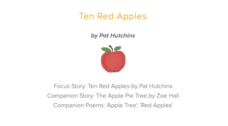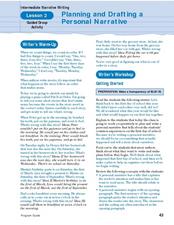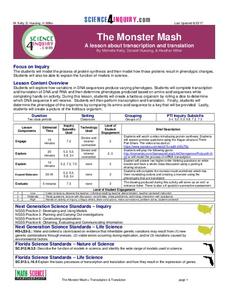Curated OER
Number Sequencing : Which Number Is Missing?
In this number order worksheet, students solve 11 multiple choice on-line interactive questions. Students analyze the series of numbers that are in order without skip counting. From four choices, students mark the number that is missing...
Curated OER
SEQUENCING A STORY WITH PICTURES: TEXT AND TALK
Third graders create a graphic organizer. They draw illustrations that show the beginning, middle and end of a trip they took to visit a friend or a relative. They write age-appropriate text to accompany each drawing. They tell...
Curated OER
Vocabulary Lesson Sequence
Students illustrate new words. In this vocabulary lesson, students learn new vocabulary words and their definitions and draw pictures to illustrate their meaning. Students complete a variety of other vocabulary activities including word...
Curated OER
Ten Red Apples; The Five Senses
A clever lesson designed around an apple awaits your learners. Descriptive words are used to explain what they believe is inside a bag while using their five senses. Students read the story The Apple Pie Tree and are introduced to the...
Curated OER
Missing Numbers to Twenty
Which number is missing? Beginning counters examine twenty-six number sequences, one for each letter of the alphabet. Each sequence has four numbers, ranging from one to 20. There is one number missing from the sequence, and learners...
Curated OER
What Shapes Can You See?
This clown is missing some things, and young counters sequence single-digit numbers to complete this juggling act. They connect four separate connect-the-dots sequences to create two triangles and two squares, then complete three more...
Curated OER
Theater Arts/Creative Movement Lesson Plan
Here is a series of five exercises intended to bring movement, dance, and theater into the classroom. Intended for special ed classes, but appropriate for any grade, learners will pantomime, play pretend, dance, move, and create...
Education Creations
Morning Math
Jump-start your morning mathematicians with this set of warm ups! Consider simply projecting the problem of the day for the entire class and having them complete the work in individual notebooks or with a partner. Concepts include...
Curated OER
Extending Geometric Patterns
Which square comes next? Each of these sequences is made up of patterned squares in a continuing order. Learners examine more squares to choose which one(s) would correctly continue the pattern. None of these have very complex sequences;...
Curated OER
Counting by 3s, 4s, and 5s
Skip count along the mushrooms to complete these number sentences which give young scholars an introductory look at addition and subtraction. Starting from five double-digit numbers, they subtract or add by threes, fours, and fives to...
Curated OER
Counting by 3s, 4s, and 5s
Can learners recognize the pattern in these number sequences? Here's a hint: it's skip counting by either three, four, or five. There are three examples at the top demonstrating each of these, and scholars complete 15 number sequences to...
DK Publishing
Counting Caterpillars
These caterpillars each have a number sequence printed on their segmented bodies, but some numbers are missing! Look at the completed caterpillars as an example, asking kids to notice a possible pattern. They should observe that the...
Curated OER
Counting Forward or Back
What comes next? Young counters follow the stone path to each house, filling in numbers in a sequence as they go. Some of these move forward and some backward, but all progress by ones. Learners start with given numbers and then follow...
Curated OER
Days and Seasons
Introduce young scholars to calendars as they practice the days of the week and four seasons. First graders complete three days-of-the-week sequences, each starting on a different day. They can reference the completed sequence example...
Curated OER
Finding Patterns
What's the pattern? Learners skip count to complete 12 sequences, some of which increase and some of which decrease. As they solve each number pattern they count by 2, 3, 4, 5, 6, 10, and 100, getting some extra subtraction and addition...
Curated OER
Frogs Hopping by 2s
Hop to it! Beginning counters fill in water lily number sequences as a frog "hops" across them, skip counting by twos. There are five sequences in total, and some require counting backward. Learners can reference the two examples, which...
Curated OER
Identifying Patterns
Find the pattern! Eighteen number sequences challenge scholars to identify and complete the pattern, adding at least four digits to the given numbers. All the sequences here involve skip counting by various single-digit numbers,...
Curated OER
Planning and Drafting a Personal Narrative
Bring your learners together to write a class narrative about the first day of school. Start off by teaching them about sequence with a quick oral activity. Then, work together to fill out a story map. Finally, compose the class...
Curated OER
Ham and Cheese Puffs
A simple cooking recipe can become an entire lesson when you have your class discuss following directions, measuring, and basic cooking skills. Intended for a special education audience, this simple dish can help build basic independent...
Hawaiʻi State Department of Education
Making Dances From Stories
After reading a short story, learners will create dances that show homophones and verbs. Their dance sequences involve three verbs and transition movements in between each verb. Tip: Have the class dance out the sequence of events from...
Illustrative Mathematics
Ordering Numbers
Deepen the number sense of young mathematicians with this unique ordering exercise. Given a list of the numbers 1, 5, 10, 50, and 100, young learners must determine where the numbers from a second list fit in the sequence. To increase...
EngageNY
The Power of Exponential Growth
How do you make a penny grow to $5,000 in just 15 days? Use the examples in this lesson plan to explore the concept of exponential growth and its comparison to linear models. Pupils come to understand that exponential growth eventually...
Science 4 Inquiry
The Monster Mash
Young scientists create monsters by applying their knowledge of transcription and translation. They randomly find the DNA, assign it a codon, and build monsters piece by piece.
National Endowment for the Humanities
George Washington: The Precedent President
Everyone knows that George Washington was the first president, but do your scholars know why that was so important? The lesson plan, the third in a sequence of three, allows learners to understand how George Washington set a precedent...
Other popular searches
- Sequencing Worksheets
- Sequencing Activities
- Story Sequencing
- Dna Sequencing
- Sequencing Events
- Sequencing Worksheets Germs
- Sequencing Stories
- Sequencing Vocabulary Words
- Story Sequencing Worksheets
- Planting Seeds Sequencing
- Free Sequencing Worksheets
- Sequencing a Story

























